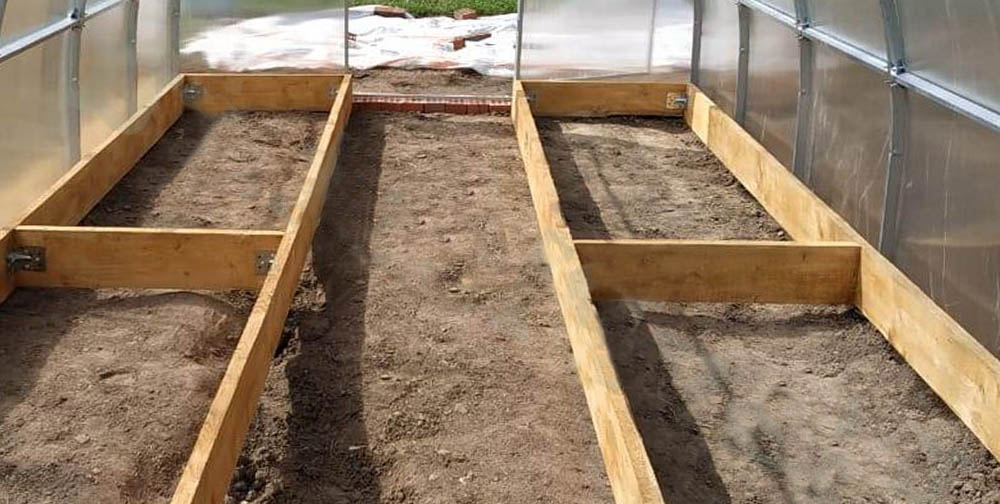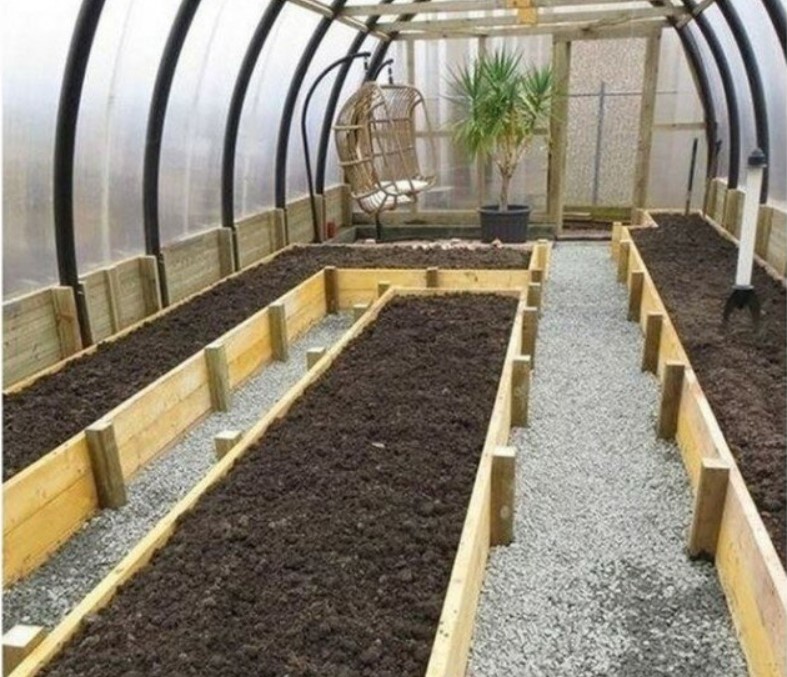Building high beds of wooden plank to make your greenhouse cleaner and more comfortable
A neat and well-groomed greenhouse is the key to a healthy harvest. Wooden plank beds keep the ground and greenhouse paths clean. They are easy to make. Therefore, many gardeners undertake to do the work with their own hands.
Practical benefits and some disadvantages of the design
Plank beds bring more than just cleanliness and neatness to the greenhouse. It doesn’t matter what kind of cover on your greenhouse: glass, polyethylene or polycarbonate. The beds increase yields due to the following advantages:
- eliminate the need for additional protection against soil erosion;
- raise the soil above the surface;
- provide plants with additional warmth, especially in spring;
- help to reduce the number of weeds;
- better retain the layer of mulch;
- accelerates the growth of planted crops.
Check out the disadvantages of the high beds
- They come in direct contact with soil and moisture, and therefore can rot and lose strength. This problem is partially eliminated by protective measures and timely care.
- Plants in raised beds need more food and water.
- Zoned greenhouse space requires strict adherence to the principle of alternation. In place of vegetables in the next season, greens should be planted and vice versa.
The nuances of planning and marking
Greenhouses vary in size and shape. Choosing the right size of boards for work and the garden bed itself means providing the gardener with convenient access to the planted plants.
Basic recommendations for the width of beds for any greenhouse
- place rows on the sides of the greenhouse walls;
- the maximum width from the wall is half a meter;
- take up the remaining space in the center of the greenhouse with another bed;
- the width of the site with an approach from both sides – up to 1.2 m;
- the distance between any adjacent ridges is from 0.5 m or more.

The height of the beds depends on the crops planned for planting. The deeper their root system, the higher the sides of the beds will be. Also, this parameter depends on the depth of the groundwater. Options for wood plank beds:
- Low. The frame rises at the level of 10-15 cm. It accumulates well and retains heat for a long time. Suitable for greenhouses on nutrient soil without groundwater proximity.
- Medium – 20-40 cm. Suitable for zucchini, cucumbers and other garden crops with a weak and shallow root system. They work on low-fertile soils, but subject to regular feeding.
- High – 40-70 cm. Gardeners use them if the site is poor or swampy. Such boxes are covered with a fertile substrate. The beds heat up faster, but they also want the most intensive watering.
Getting Started
Plank beds are an undemanding design. A beam, lining, edged board or slab will fit for it. The quality of the wood is also not important. You can use expensive larch or oak to craft, but pine or acacia is also strong enough for this mission. It is useful to pre-treat the tree from decay and bugs. Treat the procedure responsibly, otherwise impregnation risks negatively affecting the safety of the crop.
The following proucts are considered harmless:
- Paint.
- Varnish.
- A solution of vegetable oil with propolis (3: 1). The components must be mixed and applied to a clean surface.
- After drying, the procedure is repeated. During operation, it is advisable to renew the impregnation at least once a season.
- Beeswax. Environmentally friendly product.
- Lime whitewash.
- Copper sulfate. Rubbed with a sponge in a circular motion.
- Finnish mix. Ingredients: 0.5 kg of salt, 0.8 kg of flour, 1.5 kg of lime and copper sulfate. Add a small amount of water and boil, stirring until a paste is obtained. Apply hot.
Assembling a simple bed
Construction of the beds is clear even from the photo. Prepare a finished board for one construction. Calculate the length, width and height of the future bed. Basic set – 2 long and 2 short boards. You will also need 6 or more bar stakes. Sharp each one on one side.

Work order
- Start assembling the beds from the boards by attaching the posts along the edges of the short bars. Use screws or nails. Consider: the pointed edge of the bars will deepen 20-30 cm into the ground.
- Also attach 1-2 posts along the long sides of the future bed for greater rigidity.
- Nail the longer ones close to the edges of the short boards. You will have a box with stakes.
- Turn the structure upside down and place it in the desired location. Check the strict horizontal level.
High construction assembly
Collect such a bed from 2 rows of boards. If you use material 20 cm wide, then the timber in the structure should have a length of 60-70 cm. Instructions for assembling a neat-looking high bed:
- Prepare all the elements: at least 6 stakes, 4 long and 4 short pieces of the board, fasteners and a tool.
- Cut the ends of the boards with a miter box at an angle of 45°.
- Join these parts joint to joint in two rectangular boxes. Stakes will hold them together. Nail the pieces at the corners and in the center of the long sides.
- For a more aesthetic design, nail a horizontal plank with 45° cut edges to the top edge. You can put something on it or sit down while working.
- Install and align the box.

Techniques for increasing the efficiency of a high bed
- nail a metal mesh to the bottom of the box – it will save the crop from rodents;
- cover the bottom of the installed structure with geotextiles to protect against weeds;
- make the construction according to the method of warm beds.
A plank box is easy to build by yourself. The material is cheap. The design is simple. Assembling such a bed of boards will not take much time.
